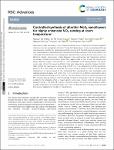Tìm kiếm theo: Tác giả Nguyen, Van Hieu
Kết quả [1 - 3] / 3
Fabrication of a high-performance room-temperature (RT) gas sensor is important for the future integration of sensors into smart, portable and Internet-of-Things (IoT)-based devices. Herein, we developed a NO2 gas sensor based on ultrathin MoS2 nanoflowers with high sensitivity at RT. The MoS2 flower-like nanostructures were synthesised via a simple hydrothermal method with different growth times of 24, 36, 48, and 60 h. The synthesised MoS2 nanoflowers were subsequently characterised by scanning electron microscopy, X-ray diffraction, Raman spectroscopy, energy-dispersive X-ray spectroscopy and transmission electron microscopy. The petal-like nanosheets in pure MoS2 agglomerated to f... |
The detection of volatile organic compounds (VOCs) is very important in practical application in breath analysis. Thus, gas sensors based on metal oxide have been fabricated, but they lacked selectivity. One approach to resolve this task is to use array of highly sensitive and selective sensors as an electronic nose. Here we present a gas sensor array of Tin oxide nano-structure use of temperature modulation techniques. A Platinum micro-heater is accompanied with the array gas sensor. The gas sensor array was composing of five single sensors and that single sensor is located at different site from the micro heater and work at different temperatures. The gas sensing properties of the g... |
This work deals with nickel electronucleation and growth processes onto a glassy carbon electrode from NiCl2·6H2O dissolved in ethylene glycol (EG) solutions with and without 250 mM NaCl as a supporting electrolyte. The physicochemical properties of EG solutions, namely, viscosity and conductivity, were determined for different Ni(II) concentrations. From cyclic voltammetry, it was found that in the absence of the supporting electrolyte, the cathodic efficiency of Ni electrodeposition is about 88%; however, in the presence of the supporting electrolyte, the cathodic efficiency was reduced to 26% due to water (added along the supporting electrolyte) reduction on the growing surfaces of... |



